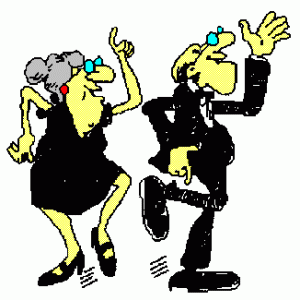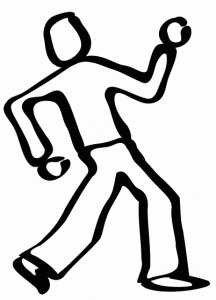 Since I wrote the post “Office Ergonomics: Why Sitting Will Kill You” I am receiving lots of positive feedback and links to articles and research on the topic. Thank you all for your enthusiasm and sharing of knowledge! Today I’m sharing with you a summary of my favorite three articles. I would encourage you to read each of these!
Since I wrote the post “Office Ergonomics: Why Sitting Will Kill You” I am receiving lots of positive feedback and links to articles and research on the topic. Thank you all for your enthusiasm and sharing of knowledge! Today I’m sharing with you a summary of my favorite three articles. I would encourage you to read each of these!
Sitting All Day: Worse For You Than You Might Think
![]() Starting with a great video to motivate a little motion while at the desk, this NPR article made me happy from the start. But then it got into the science of sitting, and it got a little darker. Steven Blair, a professor of public health at the University of South Carolina recently headed a study that looked at adult men and their risk of dying from heart disease. He calculated how much time the men spent sitting in their cars, at their desks, in front of the TV and concludes that: “those who were sitting more were substantially more likely to die.” Wow. More sitting equals more risk of death. And not just sitting in a chair — a significant amount of sedentary time was from being in cars. After reading all that, I watched the video for a second time looking for tips on how to get our of my chair more.
Starting with a great video to motivate a little motion while at the desk, this NPR article made me happy from the start. But then it got into the science of sitting, and it got a little darker. Steven Blair, a professor of public health at the University of South Carolina recently headed a study that looked at adult men and their risk of dying from heart disease. He calculated how much time the men spent sitting in their cars, at their desks, in front of the TV and concludes that: “those who were sitting more were substantially more likely to die.” Wow. More sitting equals more risk of death. And not just sitting in a chair — a significant amount of sedentary time was from being in cars. After reading all that, I watched the video for a second time looking for tips on how to get our of my chair more.
 Specifically, Steven found that men who reported more than 23 hours a week of sedentary activity had a 64 percent greater risk of dying from heart disease than those who reported less than 11 hours a week of sedentary activity. To put that in perspective, if you spend your day working at a computer you are likely logging 40 or more hours of sedentary time just at your job. Now add in time sitting and eating, sitting while driving a car, and sitting using a computer or watching TV at home. Most of us are sitting for 2 or 3 times the number of hours shown to be higher risk!
Specifically, Steven found that men who reported more than 23 hours a week of sedentary activity had a 64 percent greater risk of dying from heart disease than those who reported less than 11 hours a week of sedentary activity. To put that in perspective, if you spend your day working at a computer you are likely logging 40 or more hours of sedentary time just at your job. Now add in time sitting and eating, sitting while driving a car, and sitting using a computer or watching TV at home. Most of us are sitting for 2 or 3 times the number of hours shown to be higher risk!
The article also includes ideas from Dr. Toni Yancey, a professor in the health services department and co-director of the Kaiser Permanente Center for Health Equity at the University of California, Los Angeles, who puts it in simple terms: “We just aren’t really structured to be sitting for such long periods of time, and when we do that, our body just kind of goes into shutdown.” We’ll see in the next two articles even more data on this!
Is Your Office Chair Killing You?
Reading about the association between sitting and an increased likelihood of death from heart attacks gets my attention. But any one study can conclude anything, so it is eye-opening to read this in-depth article from Men’s Health which references more studies showing a similar increase in heart attacks among those who spend more time sitting. It even appears that studies have been coming to the same conclusion since 1953, when British researchers found that (sitting) bus drivers were twice as likely to die of heart attacks as (standing) trolley operators. What I find surprising is that:
The amount of time you exercise and the amount of time you spend on your butt are completely separate factors for heart-disease risk. New evidence suggests, in fact, that the more hours a day you sit, the greater your likelihood of dying an earlier death regardless of how much you exercise or how lean you are.
This appears to be largely driven by chemical changes in our muscles when they are active or inactive. The largest muscles in our body are in our legs and glutes and they “turn off” when we are sitting and can be activated simply by spending more time standing and moving around (read the article for more details). This is great news, since it means that we don’t need to spend 3 hours a day at the gym to be healthy, rather we just need to restructure our lives to spend more time on our feet — which we can even do while working. Like elsewhere they mention standing while on the phone, and I would add that a standing desk is probably one of the best tools for spending more time out of your chair (I intend to write in depth about sit-stand desks next — for now see my introduction on the right side-bar of this page).
This article also was a joy to read because it directly echoed and confirmed many of the ideas I’ve written about, such as how your body and fascia adapt to the sitting posture and how sitting makes one more prone to injury when doing basic things like walking. I really like the interpretation they put on aging:
“Older folks have a harder time moving around than younger people do,” says Hartman. “That’s not simply because of age; it’s because what you do consistently from day to day manifests itself over time, for both good and bad.”
 In other words, if we want to be limber and able to move with ease when we are older, we need to keep moving and using our bodies today (and every day!). I believe that many (but not all) of the aches and pains commonly associated with aging are avoidable through a love of motion and a constant effort to learn how to move and maintain engaged alignment. I’ll let you know how that theory works when I’m 90. <Grin>
In other words, if we want to be limber and able to move with ease when we are older, we need to keep moving and using our bodies today (and every day!). I believe that many (but not all) of the aches and pains commonly associated with aging are avoidable through a love of motion and a constant effort to learn how to move and maintain engaged alignment. I’ll let you know how that theory works when I’m 90. <Grin>
If heart attacks, back pain, and inflexible, fragile bodies aren’t enough, this article also mentions a study that ties the sedentary lifestyle to increased risk for Diabetes: A 2010 study in the Journal of Applied Physiology found that when healthy men limited their number of footsteps by 85 percent for 2 weeks, they experienced a 17 percent decrease in insulin sensitivity, raising their diabetes risk. For even more information on that risk, we turn to yet another article on the risks of sitting, this time from The New York Times.
This New York Times article covers even more studies on sitting and inactivity (There seem to be many!) Concerning diabetes they say the following:
This is your body on chairs: Electrical activity in the muscles drops, “the muscles go as silent as those of a dead horse,” Hamilton says — leading to a cascade of harmful metabolic effects. Your calorie-burning rate immediately plunges to about one per minute, a third of what it would be if you got up and walked. Insulin effectiveness drops within a single day, and the risk of developing Type 2 diabetes rises. So does the risk of being obese. The enzymes responsible for breaking down lipids and triglycerides for vacuuming up fat out of the bloodstream, as Hamilton puts it “plunge, which in turn causes the levels of good (HDL) cholesterol to fall.”
All that from sitting! The key point is that these effects occur as a result of the muscle becoming inactive. The solution does not require heavy exercise — merely by standing up we demand action from our muscles. Another researcher, Dr. Levine, rigorously measures the impacts of inactivity with special pairs of shorts he covered with accelerometers and inclinometers. He uses these to record every motion of the subject wearing them and tracking how much energy they consume throughout the day. This approach is much more accurate than self reported amounts of exercise. Dr. Levin then ran a study where he controlled the food and calories that the subjects ate each day, did not allow them to exercise, and then raised the total number of calories and tried to figure out why some subjects gained weight and others did not. The result was that those who gained weight simply moved less during the day while those who did not gain weight responded to the increased calories by moving more fidgeting, standing up more, walking quickly, using the stairs, etc. We all know the math: output energy must equal input energy, or we store the extra energy as fat. The key insight here is that a daylong habit of simple motion has a more significant impact on our total energy consumption than 40 minutes of hard exercise.
 Luckily, this conclusion also means that a healthy life doesn’t require a gym membership — getting out of our chairs, using a sit-stand desk, biking to work, walking more, or simply engaging our muscles through techniques like Active Sitting, can help! There is even a double payback for all this motion — our emotional self frees up and finds joy in motion! (See The Joy of Integrated Motion) As Dr. Levine says: “Go into cubeland in a tightly controlled corporate environment and you immediately sense that there is a malaise about being tied behind a computer screen seated all day. The soul of the nation is sapped, and now it’s time for the soul of the nation to rise.”
Luckily, this conclusion also means that a healthy life doesn’t require a gym membership — getting out of our chairs, using a sit-stand desk, biking to work, walking more, or simply engaging our muscles through techniques like Active Sitting, can help! There is even a double payback for all this motion — our emotional self frees up and finds joy in motion! (See The Joy of Integrated Motion) As Dr. Levine says: “Go into cubeland in a tightly controlled corporate environment and you immediately sense that there is a malaise about being tied behind a computer screen seated all day. The soul of the nation is sapped, and now it’s time for the soul of the nation to rise.”

Free yourself from sitting!! Dance, Walk, Run, Play & Move, Move, Move! There, in the freedom of motion you will find deep joy and love for life.




I totally support this. I absolutely loathe comupter work and sitting in front of a computer screen all day long. However so, the real world demands human to work like machines. Sadly.
You’ve got a wonderful site, and I’m grateful for the work you’ve put into it. Here’s an article you might like: http://alexandertechnique.com/resources/JBMT-alex.pdf
It’s by Galen Cranz, who wrote “The Chair: Rethinking Culture, Body, & Design.” She writes, “There is an inherent contradiction in our desire to sit up and lean back at the same time. Of course, the difference between a chair and a stool is the back; but if
one uses the very thing that separates a chair from its more lowly cousin, one eventually comes to the awkward realization that one is in, literally, an impossible position.”
I think she nails the problem: the chair embodies a contradiction, to be active and passive at the same time. Healthy activity involves the use of the entire body in coordinated movement; deep rest involves letting the entire body relax. The chair prevents you from doing either!
I hope to add more comment elsewhere later. For now, again, thanks and best of luck with your work and play…